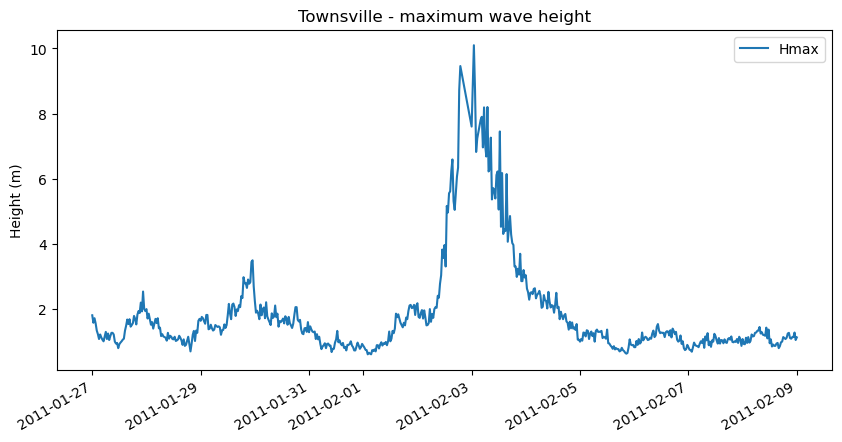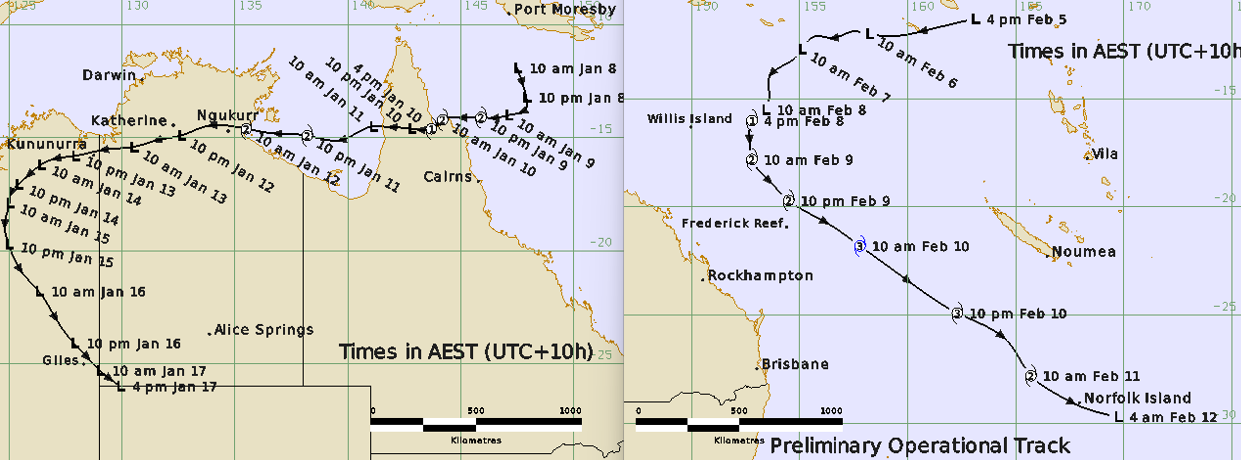Tropical Cyclones and the Great Barrier Reef
The coral of the Great Barrier Reef is not only at risk from a native predator called the Crown of Thorns Starfish, and bleaching due to increases in water temperatures, but also from tropical cyclones that smash the corals with powerful waves and currents.
Severe tropical cyclones cause significant damage to the Great Barrier Reef, particularly to the pretty, delicate acropora corals. Examples include Severe Tropical Cyclone Hamish in March 2009 and Severe Tropical Cyclone Yasi in February 2011. Both reached category 5 strength.

Image: Track maps for Severe TC Hamish March 2009 (left) and Severe TC Yasi Feb 2011 (right). Source: bom.gov.au
To get an idea about the power of the waves from a severe tropical cyclone, the following shows the maximum height of waves recorded by a buoy near Townsville reaching a peak of 10m due to TC Yasi. During the days either side of the TC crossing the waves were mainly less than 2m.

Image: Maximum wave heights recorded at Townsville buoy. Data: qld.gov.au
These tropical cyclones along with crown of thorns starfish outbreaks and coral bleaching led to rapid losses in the coral cover in the past decade. The good news is that last year the Australian Institute of Marine Science (AIMS) that monitors the coral cover reported that the central and northern regions of the Great Barrier reef had recovered to record levels. Last month AIMS published its latest update showing a pause in the rapid recovery with levels remaining close to the highs of last year. You can read these reports here and here.

Image: Regional trends in coral cover from manta tow surveys. Source: aims.gov.au
Factors that helped prevent significant damage during the last summer include lower tropical cyclone activity as well as the monsoon trough bringing cloud cover and rain that mitigated the risk of bleaching.
Tropical Cyclone Tiffany caused some damage to the northern reefs during January, but it did not have much time over the Coral Sea, briefly reaching category 2 strength before crossing the coast. Severe Tropical Cyclone Gabrielle in February could have caused more damage than Tiffany, but it was turned away from the reefs and the QLD coast by a wave in the jetstream that pushed it on towards its damaging collision with New Zealand.

Image: Track maps for TC Tiffany January 2023 (left) and Severe TC Gabrielle Feb 2023 (right). Source: bom.gov.au
With the Pacific Ocean in an El Niño state and the atmosphere beginning to respond, tropical cyclone activity in the southwest Pacific Ocean will tend to shift eastward away from QLD this summer. Of course, tropical cyclones could still impact QLD and the Great Barrier Reef, but statistically it is less likely during El Niño years. On the other hand, the north Australian monsoon tends to arrive later during El Niño years, meaning less cloud cover over the Coral Sea to mitigate the risk of bleaching. Despite the various threats to the Great Barrier Reef, it’s encouraging to see how the coral cover has recovered.